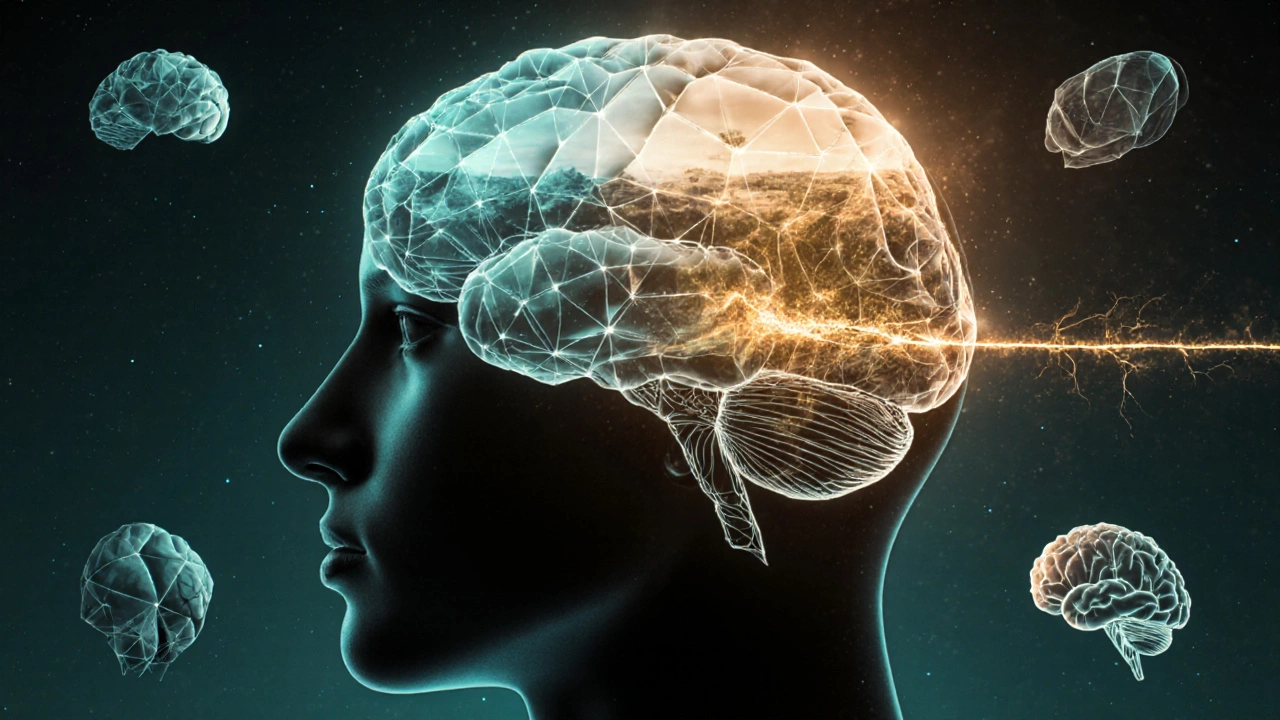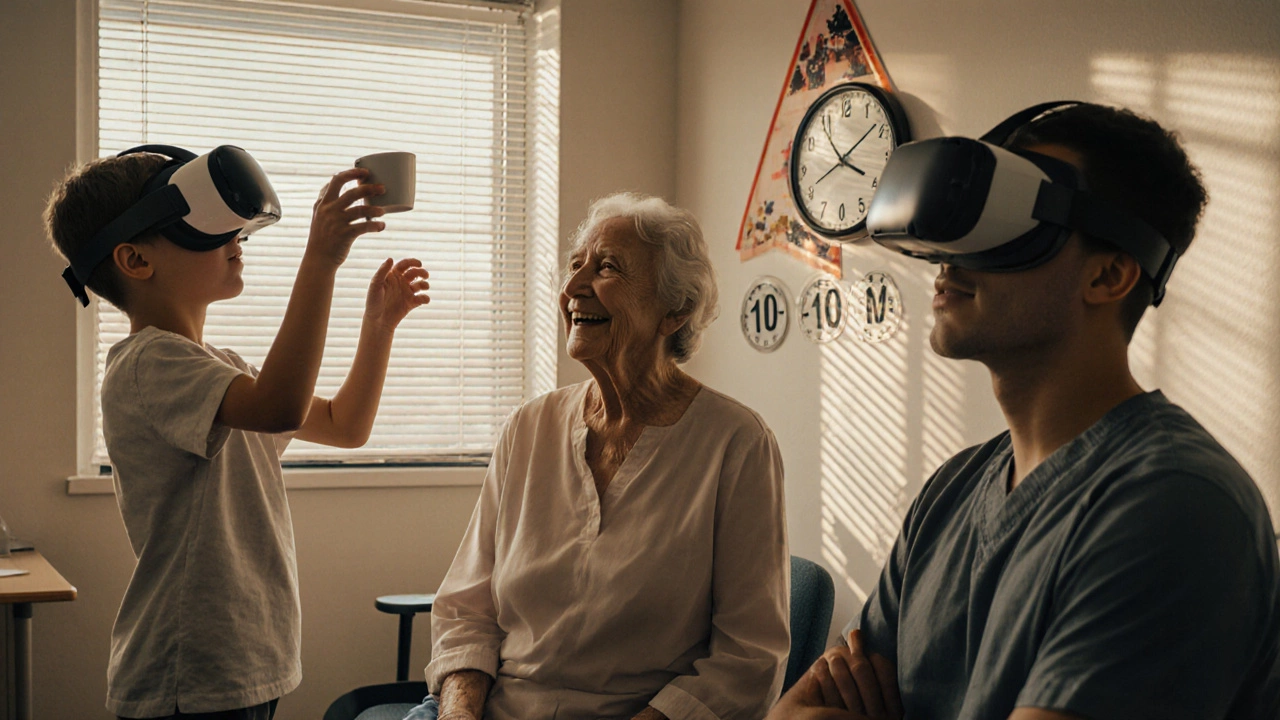VR Usage Safety Calculator
Your VR Usage Profile
Safety Recommendations
Enter your details above to see personalized VR usage recommendations.
Ever stepped into a virtual world and felt like your brain was doing backflips? You’re not alone. Millions of people use VR headsets for gaming, workouts, therapy, and even work meetings. But as the tech gets more immersive, a quiet question keeps popping up: Is VR safe for your brain? It’s not just about eye strain or dizziness. We’re talking about real, measurable changes in how your brain processes space, time, and even reality itself.
What Happens in Your Brain During VR?
When you put on a VR headset, your brain gets tricked. Your eyes see movement, your inner ear feels stillness, and your body doesn’t move the way your senses say it should. This mismatch is called sensorimotor conflict. It’s why some people get nauseous in VR - your brain thinks you’re moving, but your body isn’t. That’s the short-term stuff.
But long-term exposure? That’s where things get more interesting. A 2024 study from the University of California, San Francisco tracked 120 adults using VR for 30 minutes a day, five days a week, over six months. Researchers found subtle but consistent changes in the hippocampus - the part of the brain responsible for spatial memory and navigation. Participants showed improved spatial awareness in virtual environments, but when tested in real-world navigation tasks, some showed slight delays in recalibrating to physical space. Think of it like jet lag for your brain’s GPS.
Is VR Rewiring Your Brain?
Yes - but not in the way you might fear. Your brain is plastic. It adapts to what you feed it. If you spend hours flying through alien galaxies or fighting zombies in a virtual dojo, your brain gets better at those tasks. That’s not bad. In fact, VR is already being used in rehab for stroke patients to help rebuild motor skills, and in PTSD therapy to safely expose people to trauma triggers.
But here’s the catch: the brain doesn’t know the difference between virtual and real when it’s deep in immersion. A 2023 fMRI study from MIT showed that when users experienced a virtual threat - like a virtual snake lunging at them - the amygdala, the brain’s fear center, lit up just as strongly as if it were real. Your heart races. Your palms sweat. Your stress hormones spike. That’s powerful. And if you’re using VR daily for high-intensity, emotionally charged experiences, your brain might start treating virtual stress like real stress.
Who’s at Risk?
Not everyone reacts the same. Children under 13 are still developing their spatial perception and sense of self. The American Academy of Pediatrics recommends avoiding prolonged VR use in young kids. Why? Because their brains are still learning how to distinguish fantasy from reality. A 2025 meta-analysis of 17 studies found that kids under 12 who used VR more than 4 hours a week showed increased instances of temporary confusion between virtual and real objects - like reaching for a virtual cup and missing it, then staring at the empty space where they thought it was.
Adults with anxiety disorders, epilepsy, or vestibular conditions (like vertigo) should also proceed with caution. A 2024 case report in the Journal of Neurology described a patient with mild epilepsy who had a seizure after a 20-minute VR session with rapid flashing lights and intense motion. That’s rare, but it happened.
And then there’s the issue of dissociation. Some users report feeling “out of body” after long sessions. One gamer told researchers, “I’d take off the headset and feel like I was still floating in the game world for five minutes.” That’s not hallucination - it’s neural afterglow. Your brain needs time to reset.

How Long Is Too Long?
There’s no official FDA guideline, but most experts agree on a simple rule: 20 minutes on, 10 minutes off. That’s not arbitrary. It’s based on how long it takes the brain to reset its vestibular system and re-sync with physical gravity.
Use the 20-20-20 rule too: every 20 minutes, look at something 20 feet away for 20 seconds. This helps reduce eye strain and gives your visual cortex a break. If you’re doing VR for work or therapy, schedule breaks like you would for a meeting. Don’t just power through.
And avoid VR right before bed. A 2025 sleep study from Stanford found that users who engaged in high-immersion VR within two hours of bedtime took 22% longer to fall asleep and had reduced REM sleep. Your brain is still processing the virtual world - it doesn’t know it’s time to shut down.
Benefits That Outweigh the Risks
Let’s not ignore the upside. VR isn’t just entertainment. It’s a medical tool. In hospitals, VR is used to reduce pain during wound care - patients report up to 50% less discomfort when immersed in calming virtual environments. In education, medical students use VR to practice surgeries with zero risk. For people with social anxiety, VR exposure therapy has helped over 70% of participants reduce avoidance behaviors in real life.
Even in everyday life, VR helps. Older adults using VR to “visit” family or travel to familiar places show measurable drops in loneliness and depression. A 2024 trial with 300 seniors found that those who used VR for 15 minutes daily, three times a week, had better mood scores than those who didn’t.

What You Can Do to Stay Safe
If you’re using VR regularly, here’s what actually works:
- Stick to the 20-10 rule: 20 minutes of VR, then 10 minutes out of the headset.
- Avoid VR if you’re tired, stressed, or hungover - your brain is already overloaded.
- Use only certified content. Avoid pirated or untested apps - some have hidden flickering lights or sudden loud noises that can trigger seizures or panic.
- Don’t use VR in the dark. Ambient light helps your brain stay grounded in physical space.
- Watch for symptoms: persistent dizziness, blurred vision after removal, or feeling detached from reality for more than 15 minutes after use - stop and consult a doctor.
Most importantly: listen to your brain. If something feels off, it probably is. You wouldn’t ignore a headache from staring at a screen for hours. Don’t ignore the quieter signals your brain sends in VR.
Is VR Safe? The Verdict
VR isn’t dangerous for most people when used responsibly. But it’s not harmless either. It’s a powerful tool that reshapes how your brain works - for better or worse. Think of it like a gym for your mind. Too little, and you don’t get stronger. Too much, and you risk injury. Balance is everything.
The science is clear: short, controlled sessions with breaks are safe. Long, unbroken immersion without recovery time? That’s where risks creep in. For kids, older adults, and people with neurological conditions, extra caution isn’t optional - it’s necessary.
VR isn’t going away. It’s getting better, faster, and more real. The question isn’t whether it’s safe. It’s whether you’re using it in a way that respects your brain’s limits.
Can VR cause permanent brain damage?
There’s no evidence that VR causes permanent brain damage in healthy adults when used within recommended guidelines. Studies have shown temporary changes in spatial perception and stress responses, but these reverse after periods of rest. Long-term studies spanning over five years have not identified structural brain changes linked to VR use. However, excessive, unbroken exposure - especially in children or those with pre-existing neurological conditions - may contribute to prolonged disorientation or anxiety symptoms that require medical attention.
Is VR safe for kids?
Most manufacturers recommend VR headsets for ages 13 and up, and for good reason. Children’s brains are still developing their sense of spatial awareness and reality testing. Studies show kids under 12 who use VR frequently are more likely to experience temporary confusion between virtual and real objects, and may have trouble with depth perception afterward. Limit use to under 15 minutes per session, and always supervise. Avoid high-intensity or scary content. Think of it like screen time - moderation and age-appropriate content matter most.
Does VR affect memory?
VR doesn’t erase memory, but it can temporarily interfere with how your brain encodes real-world spatial information. A 2024 study found that after prolonged VR sessions, participants took longer to recall the layout of a real room they’d just walked through. This is because the brain’s navigation system gets overloaded with virtual cues. The effect fades within an hour after removing the headset. In fact, VR is being used to improve memory in Alzheimer’s patients by recreating familiar environments - showing it can help memory too, when used therapeutically.
Can VR trigger seizures?
Yes, but it’s rare. People with photosensitive epilepsy can have seizures triggered by rapid flashing lights, high-contrast patterns, or sudden bright changes in VR - just like with video games or TV. Reputable VR platforms now include warnings and settings to reduce flicker. Avoid unverified apps or games that haven’t been tested for accessibility. If you’ve ever had a seizure triggered by screens, talk to your neurologist before trying VR. Use the built-in safety filters, keep the brightness low, and avoid dark rooms during use.
Why do I feel dizzy after taking off my headset?
That’s called VR-induced motion sickness, or “simulator sickness.” It happens because your inner ear (which senses balance) says you’re still, but your eyes say you’re moving. Your brain gets confused. This usually lasts only a few minutes after removing the headset. To reduce it: take breaks every 20 minutes, avoid fast movement in VR, use teleportation instead of smooth locomotion when possible, and make sure your headset is properly calibrated to your interpupillary distance. If dizziness lasts longer than 30 minutes, stop using VR and consult a doctor.

